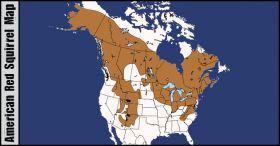The American Red Squirrel
Tamiasciurus hudsonicus
The American Red Squirrel (Tamiasciurus hudsonicus) is an extremely common squirrel in North America. It should not be confused with the European Red Squirrel which is one of the most common Eurasian squirrels.
American Red Squirrels are found in most areas of the US where conifers are common. In the southern Rockies there is a subspecies that is commonly refered to as the Spruce Squirrel. It is not nearly as red as the squirrels found farther north. In fact, the squirrel highlighted on this page would be considered a Spruce Squirrel (it was filmed at 10,000 feet in the mountains near Fairplay, Colorado).
What preys upon the Red Squirrel?
There are several animals that eat Red Squirrels. While not all predators are found throughout its range, these are a few of the main predators: Coyotes, Bobcats, Canadian Lynx, Great Horned Owls, Northern Goshawks, Red-tailed Hawks, American Crows, Red Foxes, American Marten, Wolves, and Weasels. Yet, it has been reported that predators likely eat few adult squirrels as part of their normal diet.
How long do Red Squirrels live?
Like most squirrels, the American Red Squirrels have high early mortality. Only about 22% of young survive to reach one year of age. One study showed that females that survive to at least one year of age have an average life expectancy of 2.3 years. Maximum ages are usually about eight years for Red Squirrels.
How do Red Squirrels reproduce?
Red Squirrels usually only mate only once a year, and females come into estrus only one day a year. This is what is known as a spontaneous ovulator.
After mating, it takes between 31 and 35 days before the young are born. At that time an average of three or four young are born. They stay with the mother for around 70 days before they venture out on their own. Most females could reproduce at one year of age, but they often wait to reproduce when they are two years old.
References
- Layne, J. N. 1954. The biology of the red squirrel Tamiasciurus hudsonicus loquax in central New York. Ecological Monographs 24:227-267.
- Millar, J. S. 1970. The breeding season and reproductive cycle of the
western red squirrel. Canadian Journal of Zoology 48:471-473.
- Lair, H. 1985. Length of gestation in the red squirrel, Tamiasciurus hudsonicus. Journal of Mammalogy 66:809-810.
Related Topics
The American Red Squirrel (Tamiasciurus hudsonicus) is an extremely common squirrel in North America. It should not be confused with the European Red Squirrel which is one of the most common Eurasian squirrels.
American Red Squirrels are found in most areas of the US where conifers are common. In the southern Rockies there is a subspecies that is commonly refered to as the Spruce Squirrel. It is not nearly as red as the squirrels found farther north. In fact, the squirrel highlighted on this page would be considered a Spruce Squirrel (it was filmed at 10,000 feet in the mountains near Fairplay, Colorado).
What preys upon the Red Squirrel?
There are several animals that eat Red Squirrels. While not all predators are found throughout its range, these are a few of the main predators: Coyotes, Bobcats, Canadian Lynx, Great Horned Owls, Northern Goshawks, Red-tailed Hawks, American Crows, Red Foxes, American Marten, Wolves, and Weasels. Yet, it has been reported that predators likely eat few adult squirrels as part of their normal diet.
How long do Red Squirrels live?
Like most squirrels, the American Red Squirrels have high early mortality. Only about 22% of young survive to reach one year of age. One study showed that females that survive to at least one year of age have an average life expectancy of 2.3 years. Maximum ages are usually about eight years for Red Squirrels.
How do Red Squirrels reproduce?
Red Squirrels usually only mate only once a year, and females come into estrus only one day a year. This is what is known as a spontaneous ovulator.
After mating, it takes between 31 and 35 days before the young are born. At that time an average of three or four young are born. They stay with the mother for around 70 days before they venture out on their own. Most females could reproduce at one year of age, but they often wait to reproduce when they are two years old.
References
- Layne, J. N. 1954. The biology of the red squirrel Tamiasciurus hudsonicus loquax in central New York. Ecological Monographs 24:227-267.
- Millar, J. S. 1970. The breeding season and reproductive cycle of the
western red squirrel. Canadian Journal of Zoology 48:471-473. - Lair, H. 1985. Length of gestation in the red squirrel, Tamiasciurus hudsonicus. Journal of Mammalogy 66:809-810.

































































































